The following article has been extracted from the Technical Articles for Milsurp Collectors and Re-loaders (click here)Ross M-10 Rifle Bolt Disassembly
by "PerversPépère"
Note: After you click on images to ENLARGE them, you may find they automatically size smaller in your browser's window making them harder to view. The auto sizing is your browser's way of keeping images entirely within the screen size you have set. Move your mouse pointer to the bottom centre of the pic and you will see an options panel appear. There will be a small square box next to the large X, which will have a pointer arrow sticking out of it. If it's illuminated, it means the pic you're viewing can be enlarged, so click on this box and the pic will EXPAND and open to its normal size.
Here are some pics to help you in your first try at this "daunting" task. I had to take the pics in a hurry to help a CanadianGunNutz member and some of the pics aren't perfect but I promise to redo some of them for more clarity.
OK, let's roll! First, you have to take the extractor out by lifting it to clear the retaining groove on the bolthead. To do this, place a flat-bladed screwdriver under the extractor near the groove and pry just enough to clear the groove. Push on it outwards and it's done.
(Click PIC to Enlarge)
==================================================
Now take time to inspect the rear part of the bolt; notice there is a through hole at the end of the firing pin. Thread a wire or a hook into that hole to give you some purchase.
(Click PIC to Enlarge)
==================================================
Put the bolt in a vice with padded jaws so it cannot move; pull on the firing pin and place a small 1 1/4" wood block in he sear block groove.
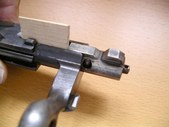
(Click PIC to Enlarge)
==================================================
You'll notice a short, fat crosspin with rounded ends; this is the pin that secures the firing pin into the sear block. Push it out with a nail driver while keeping tension on the firing pin; it doesn't need much effort to slide out. Take the wood block out and let the firing pin come to rest slowly.
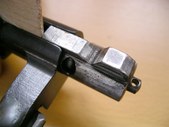
(Click PIC to Enlarge)
==================================================
Here's the sear and crosspin out
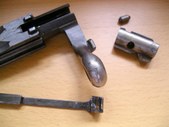
(Click PIC to Enlarge)
==================================================
Now, after marking them, grasp the two parts of the bolt and slowly unscrew them. Mark the point where they separate with a marker or machinist scribe if you intend to use strong solvents. Here are the two parts of the bolt and assorted bits.
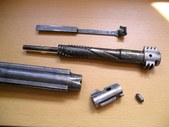
(Click PIC to Enlarge)
==================================================
Now, you have to take the firing pin and its spring out. There is a threaded stopper at the rear which has two ears; it unscrews in the normal manner but there is a special retainer behind it that prevents any unwanted unscrewing. It clicks on every half-turn. Adjust your bench vise jaws open just enough to let the firing pin pass and unscrew the firing pin stop by turning the bolt body. Here's the part with the bolt stop unscrewed one turn for clarity.
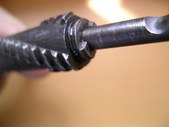
(Click PIC to Enlarge)
==================================================
Here's the firing pin and related parts still assembled; notice the special retainer washer with outside projection and two locating nubs on its surface: that projection fits in a groove inside the bolt sleeve (to keep the washer from rotating) with the twin nubs facing outwards toward the threaded stopper.
(Click PIC to Enlarge)
==================================================
Here are the parts disassembled
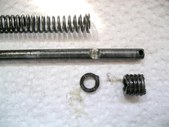
(Click PIC to Enlarge)
==================================================
And here is the elephant, skinned, quartered and ready for cleaning.
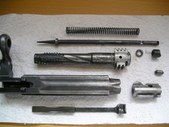
(Click PIC to Enlarge)
Observations: (by "PerversPépère")
If your bolt is of the "safety rivet" kind, there's only one way to reassemble it; for the "unrivetted" ones (much rarer) you can fumble it but there is only one position where reassembly is smooth. One surefire way to be certain: the gas port will face up when the bolt is in the open position. Now, reassembly is in the exact reverse order BUT there's a trick: when you have finally succeeded in starting the inner bolt inside the sleeve, you'll reach a point where the bolthead cannot turn the final 80-90 degrees. You have to pull apart the two pieces ever so slightly and you'll feel a slight 1/16" movement then the bolthead will rotate in place.
This last stage can drive you crazy if you don't do it right but it is so smooth once you discover the Ali Baba's secret move, you won't believe!
Good cleaning and NEVER force anything: if you have to force, something is wrong.
Collector's Comments and Feedback:
1. CAUTION: I have an update on the unpinned bolts by Tiriaq that is quite chilling! He sent me two pics of an actual unpinned M-10 bolt that has been reassembled WRONG!. From what I understand, there is no real effort in reassembling an unpinned bolt in the wrong way. The only problem is when one tries to put it back in the rifle, but, given enough ham-fisted stubbornness it can be done with potentially DEADLY results. The bolthead doesn't lock but engages just enough to permit firing pin spring tension to be established and pressure of the trigger can fire the primer!
(Click PIC to Enlarge)
After studying these images and discussing them with Tiriaq, I came to the conclusion that there can be a sure-fire way of knowing if your bolt has been reassembled correctly:
(a) Make sure that there are no ammo left in the magazine and action.
(b) Pull back on the bolt; you should feel a definite tension working against the opening. This is caused by the camming of the rotating bolthead against the firing pin spring.
(c) Open the bolt fully, then slide it closed but do not push the bolt past the resistance point which cams the bolthead and makes it rotate back into its lug recesses.
(d) Press the trigger with the barrel pointing downwards. If correctly reassembled, the bolt will snap shut from the firing spring thrust and rotation of the lugs.
(e) Now that the action is relaxed, pull the bolt back. You should need a fair amount of muscle to open it, cam the spring into compression and rotate the lugs open.
Feedback by "PerversPépère" and "Tiriaq"
2. Update Aug 10th, 2006: I went on Gunboards forum and one of the subjects delved into the M-10 Ross peculiarities and the infamous "bolt not locking" problem. So I started there the same thread we have been discussing here, with the pics and additions. A Gunboards member added a comment I found to be of the utmost importance.
I think this can explain a lot of the accidents that happened when the bolts were not riveted to prevent the bolthead to go 180 degrees. This could be avoided by looking to make sure the gas port was turned upwards when in the retracted position but, in combat zones, there were many instances where that simple check could be skipped...(Feedback by "PerversPépère")"The bolt of an un-riveted M-10 does NOT need to be disassembled to cause the bolthead to not rotate.
If you pull the bolt from the rifle, you will notice (assuming the bolt is in the correct way to begin with) the bolthead rotate and extend from the bolt sleeve--if you don't, you have a problem! Pull the bolt from the rifle, the bolthead may snap back into the sleeve--probably will, in fact.
Grasp the bolthead and pull and rotate it back out as it should be to insert it into the rifle. It'll sort of snap into a small detent.
NOW...if you continue to rotate the bolthead the same direction about 1/8 of a turn, suddenly the bolthead will snap back into the bolt sleeve. However, notice that the threaded lugs are now very nearly in the same position as they are when the sleeve is extended.
With a little fiddling, the bolt can be inserted into the rifle.
Of course, with the bolthead retracted, it's not going to turn into the receiver, it'll simply close without locking. Pull the trigger in this state, and GunNutz is out a member."
Note: The opinions expressed herein or statements made in this article are solely those of the author, and do not necessarily reflect the views of the Military Surplus Collectors Forums, or the ownership and moderation group of this site. MILSURPS.COM accepts no legal liability or responsibility for any claims made or opinions expressed herein. Also, please note that neither the author nor MILSURPS.COM recommends that any member of these forums, or a reader of this article, try this type of experimentation without the proper knowledge, equipment and training.Information

Warning: This is a relatively older thread
This discussion is older than 360 days. Some information contained in it may no longer be current.
- Knowledge Library

- MKL Entry of the Month
- Australia
- Austro-Hungarian Empire
- Canada
- Czechoslovakia
- Denmark
- Finland
- France/Belgium
- Germany
- Italy
- Japan
- Norway
- Russia
- South America
- Sweden
- Switzerland
- Turkey
- United Kingdom
- United States
- Yugoslavia
- Is my rifle authentic or a fake?
- Jay Currah's Lee Enfield Web Site
- On-line Service Records (Canada)
- Technical Articles/Research
- Forum
- Classifieds

- What's New?
-
Photo Gallery

- Photo Gallery Options
- Photo Gallery Home
- Search Photo Gallery List
-
Photo Gallery Search
- Video Club

- iTrader













 PM
PM






